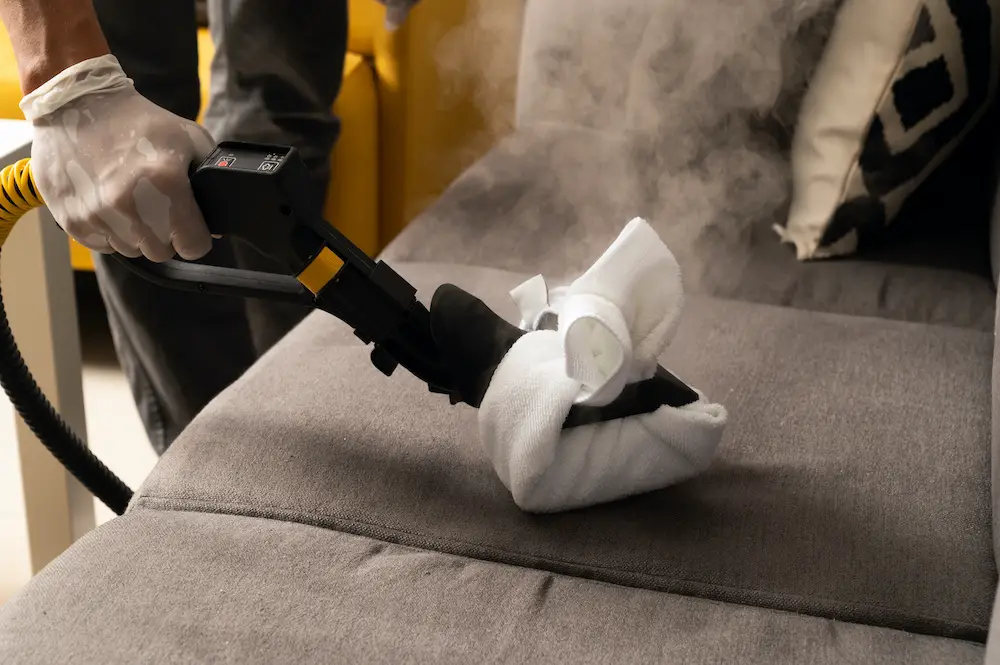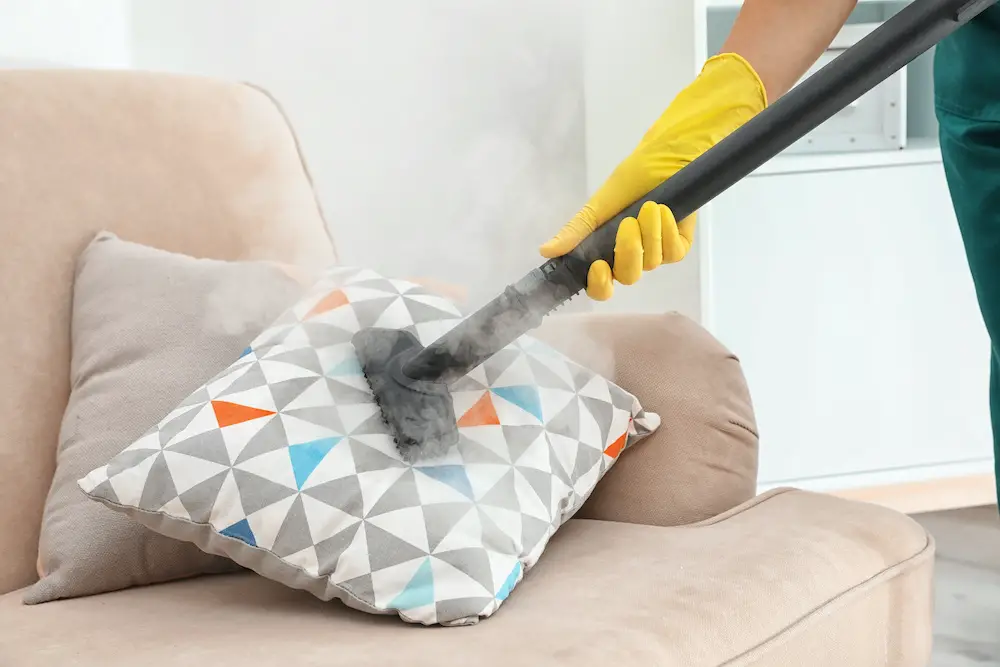Looking for efficient hacks to effectively clean upholstery with a steam cleaner?
These machines aren’t cheap, and yours isn’t doing you any good collecting dust in your garage.
In that case, you’d be thrilled to know that you can use it to clean different surfaces, including fabrics.
Here, we’ll list the steps to learn how to clean upholstery with a steam cleaner.
We will also give you tips for maintaining it, using only a few basic items you can easily find in your home.
Can You Use a Steamer To Clean a Couch?
Of course, a couch is a type of upholstered furniture.
Every upholstery material attached to it requires its own method of cleaning and upkeep.
Before you can learn how to steam clean a couch, you have to understand fabric cleaning codes first.
Fabric codes are universal cleaning instructions you can find on small tags somewhere in your sofa’s fabric.
To steam clean couch upholstery the right way, look for the cleaning codes to know whether you can use a steam cleaner on the fabric or not.
If you bought the couch from a popular furniture store, there is a good chance that the cleaning code is on the tag.
However, if you had someone reupholster your couch, check with the fabric supplier for the cleaning instructions.
Fabric Cleaning Codes
Use the following list as a reference for determining how to steam clean upholstery at home.
Code W
Use only water-based solutions for fabrics labeled with the code “W.”
Do not over-wet upholstery fabrics with this label, and do not use solvents to spot clean.
Also, do not separate from the cushions and do not machine-wash.
Code S or P
Use only dry-cleaning solvents to clean fabrics with the “S” or “P” labels. Code “S” Upholstery fabrics labeled as Code “S” must be dry solvent cleaned only.
Dry solvent cleaning is reserved for delicate or non-colorfast fabrics that can be damaged when using water-based cleaning methods.
Do not saturate nor use water on these fabrics. Do not remove the fabrics from the cushions and do not machine-wash.
Code W/S or S/W
S-W means you can use either a solvent or water to clean a microfiber couch
Alternate use between water-based solutions and mild dry-cleaning solvents when cleaning upholstery fabrics with the label “W/S” or “S/W.”
Do not saturate these fabrics with any liquids. Do not remove, separate, or machine-wash the fabrics.
Some fabrics with the “W,” “S,” “P,” or “S/W” labels may require some brushing for appearance restoration.
Code X
Only use a soft-bristled brush or a vacuum cleaner to remove dirt and stains from fabrics with the label code “X.” Do not wet or dry clean these fabrics.
Code D or DC
Use only dry-cleaning solvents to clean fabrics with the “D” or “DC” labels.
You can remove the fabrics from the cushions and subject them to a full dry-cleaning process.
Code WASH
For furniture with the “WASH” label, separate the fabrics from the cushions and machine-wash with water-based detergents.
Code N Fbr
Do not wet or saturate upholstery material with the “N Fbr” tags. These labels stand for “natural fiber.”
Natural fibers require immediate blotting of spills with a clean white cloth or some plain paper towels.
You can use mild water-based solutions, baking soda, and vinegar for dabbing stained spots.
Leather Couch
Can I steam clean my leather couch? For safety, always test in an inconspicuous area first.
Yes! If you feel like giving your leather couch a deluxe cleaning treatment, then steam cleaning is the way to go.
It is an effective way to rid your leather couch of molds, dirt, and stains. Steam cleaning also removes 99 percent of germs due to its hot water solution
Suede Couch
Can I steam clean my Suede Couch? For safety, always test in an inconspicuous area first.
Yes! Even Suede couches, though they may need brushing after to restore the nap, or raised look of the suede.

How To Clean Upholstery With a Steam Cleaner
Now that you understand the cleaning codes for fabrics, you can now determine whether to steam clean couch upholstery or not.
Be careful when cleaning around upholstery made of natural fiber.
Go for the more straightforward white cloth or paper towel dabbing method to immediately remove some stains.
For the best results, ask the manufacturer how to steam clean a couch from their collection.
In most cases, you can use a steam cleaner to clean upholstery with the “W,” “WS,” or “WASH” tags.
Some types of steam cleaners use low moisture or dry steam. These steam cleaners work great for upholstery with the “S,” “D,” or “DC” tags. For safety, always test in an inconspicuous area.
If your upholstery has the “X” tag, you should not wet or steam clean it. Any amount of moisture will permanently damage the fabric.
Here are the step-by-step instructions for steam cleaning upholstery with the abovementioned tags:
Step 1: Prepare all the tools and supplies.
For a continuous cleaning process, prepare all the tools you might need.
Here are the tools and supplies that can help you successfully steam clean couch upholstery:
The Basics
For the essential tools, bring out a brush with soft bristles, a sponge, some pieces of white linen or cotton cloth, a spray bottle, and a small bucket or container.
Equipment
Bring out your vacuum cleaner and steam cleaner.
If you have different steam cleaners, check which one is best for the type of upholstery you are about to clean.
Cleaning Supplies
Fill the bucket partially with water, prepare some dish soap, laundry detergent, and some heavy-duty cleaning solution.
Common Household Remedies
You might also want to prepare some baking soda and vinegar.
This solution can help remove stains that are too tough for other cleaning supplies to remove.
Step 2: Prepare the upholstery.
With a vacuum cleaner or a soft-bristled brush, remove all trash, dirt, dust, and pet hairs from all the surfaces of the upholstery.
You may want to separate the cushions from the main furniture if you are working on a couch.
Removing all of the visible particles while the furniture is completely dry eliminates the possibility of it becoming even dirtier when the debris gets wet.
Do this carefully to ensure you get rid of the debris as much as you can.
Step 3: Pre-treat the stains.
Dilute some mild cleaning soap in water and put it in a spray bottle.
If your couch has any visible stains that have hardened and cannot be removed by a brush or a vacuum cleaner, spray some of your cleaning solution on them.
Then, rub the stained area with a few strokes from the sponge.
Wait for a few minutes for the stain to soften up under the cleaning solution.
Once the stain looks broken down, blot the area with a white cloth or toilet paper to pull out the stain and dry up the cleaning solution.
Step 4: Steam clean everything.
Your steam cleaner may have several attachments for cleaning different types of materials and surfaces.
Assemble your steam cleaner with a fabric cleaning attachment, and fill its tank with water.
Wait for it to heat up before having the attachment run through every corner, crevice, and surface of your furniture.
Working a steam cleaner is like using a vacuum cleaner, so be sure to run the steam attachment over every upholstery surface.
Step 5. Check and remedy the remaining stains.
As you go through steam cleaning on all the parts of your furniture, check for remaining stains.
Before applying any cleaning solution to stained areas, always test for colorfastness.
Do this by testing the solution onto an inconspicuous area of the upholstery.
If a simple soap and water solution cannot handle the stain, try dabbing the stained area with some baking soda and use a brush to remove the blemishes gently.
You can also try vinegar to soften up any hardened objects left on the upholstery. Mix the vinegar with some baking soda for even more impressive results.
If these home remedies do not work, try for commercially available heavy-duty cleaning chemicals, but remember to test it with the fabric first.
Step 6: Dry the cushions and the rest of the furniture separately.
Completely dry every cushion and all the parts of the upholstery before using the furniture.
Leaving a piece of upholstery damp and using it as it is can cause it to produce unwanted foul odors.
How Do You Steam Clean a Couch Without a Steam Cleaner?
If you do not have a steam cleaner, you can learn how to steam clean upholstery with any standard clothes iron.
Replace Step 4 in the previous section with the following procedure:
- Get a piece of linen or cotton cloth and dampen it with water.
- Lay the cloth flat on the upholstery surface and press down on it with a hot clothes iron.
- Do not keep pressing for more than 30 seconds, or you might burn the fabric and damage it permanently.
Remember to dampen the cloth each time because the hot iron converts the moisture to steam.
Conclusion: How Do You Deep Clean Upholstery?
Learning how to clean upholstery with a steam cleaner is the best-proven practice to deep clean upholstery.
Since furniture and car seats are very bulky, there is no easy way to wash out all dirt and stains thoroughly.
Plus, not all fabrics retain quality after being subjected to moisture and saturation.
The simplest way to clean upholstery is to use a vacuum cleaner, but a vacuum cleaner cannot do a deep clean.
Steam cleaners produce steam that can kill even the germs and allergens deep within the upholstery.

